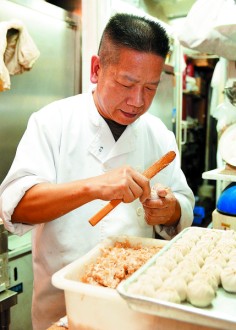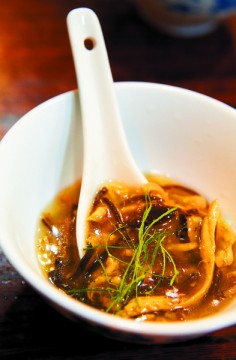
Foodie tours hit the spot
Guided food tours are a fascinating way to learn about local culture and customs, writes Anneliese O'Young
be a mystery for new arrivals or visitors. Not everyone feels comfortable sitting down at a table in a random restaurant, pointing to whatever a nearby person is having, and then eating something that they can't quite identify.
But learning about the food here is vital to understanding what makes Hong Kong tick. If you're pressed for time, there's no easier way than paying a guide to help navigate what's off the "eaten" track.
One such service is offered by Urban Discovery, which was founded by Ester van Steekelenberg with the aim of creating learning products that show Hong Kong's cultural heritage.
"The culinary walk is one of our products, but we also have a range of souvenirs, and will launch an iDiscover city walk app next month," says Van Steekelenberg, who originally hails from the Netherlands.
Edmond Lam, Urban Discovery's event manager and tour guide, hosts weekly walks through the heart of Kowloon, from Prince Edward to Jordan with groups of two to six people.
"Through intimate walks, we want to share the stories and lifestyle of typical Hongkongers with visitors and newcomers to Hong Kong," says Lam.
"As food is central to the culture of Hong Kong, we explore the stories behind such things as wonton noodles, snake soup and turtle jelly on a walk through the very heart of Kowloon. At the final stop we give our clients a souvenir of a small map with different dishes and destinations, so they can retrace their steps on their own."
Lam recently hosted Australian Kim Dienhoff, who joined a personalised tour with Urban Discovery because she wanted to try something new.
"Hong Kong has its own perspective on local and fusion food both traditional and modern," says Dienhoff. "A food tour gives you a different perspective and helps to broaden your knowledge of local culture and people. That's especially so in Hong Kong, where eating together with friends and family is so important."

"The most memorable moment of the tour was finding that, much to my surprise I really quite liked turtle jelly," Dienhoff says. "I found it refreshing, and the story is very interesting."
This medicinal gelatin dessert is traditionally made from the powdered bottom shell of the turtle. It is said that Emperor Tongzhi was nearly cured of smallpox thanks to the turtle jelly, although he still died soon after.
Today, in more commercial shops, the dessert, which is bitter and therefore eaten with sugar syrup, is not made from turtle shell. It's made from a herbal mixture, and is considered to be good for one's complexion.
"What we do is open up the door to people who are interested in seeing a different side of Hong Kong," says Lam. "It is more than just foreigner and local. It's a celebration of things in Hong Kong that people take for granted, as our love of food binds us all together."
Cecilia Leung, director of Hong Kong Foodie Tours , gave her first tour in Sheung Wan last year, and has recently expanded to include a trip through Sham Shui Po.
"The idea of starting the business was built on my passion for food," says Leung, who was a tour operator in America. "When I came back to Hong Kong, I would find myself hosting my visiting friends. It was a natural evolution from there."
On a busy week, Leung's company conducts six tours a week with a set itinerary, although it can also do private, personalised tours for groups. Numbers are limited to 12 and participants range from first time tourists who are not familiar with Chinese cuisine to repeat visitors looking for something more personal.
"There aren't that many licensed walking tours around," says Leung. "We often get requests from tour companies, but our concept is very different from the traditional bus tours. We don't just feature the food, we take in the flavour of the local community.
"In Sham Shui Po, there hasn't been a lot of rejuvenation. There is a lot of traditional Hong Kong culture still there, and our guests see it as we walk through the district in the mornings."
Adrianne Lynch, conference and incentive travel manager at DMC - The Destination Management Company, has watched the trend for personalised tours grow in the past few years. "Hong Kong is a popular destination, especially for repeat visitors and clients are always interested in meaningful experiences," says Lynch, who has lived in Asia for over 20 years. "Visitors today are more discerning and educated about travel experiences. Food tours are a sign of a more global clientele who cherish intimate tours which give them a glimpse into the authentic and local life.

"What makes smaller tours so successful and popular is that they introduce foreigners to a type of cuisine that is not as accessible to foodies who can't speak Cantonese. Food is a universal language, so it is no wonder that clients rave about the experiences," Lynch says.
The popularity of blogging, increased social media and the growing number of cooking shows means that more travellers are focusing on food when they go abroad. Everyone is a critic and reading other people's experiences can only take you so far. People are interested in touching and tasting the food for themselves, and food tours allow them to do that. Little Adventures in Hong Kong was started in 2009 by managing director Daisann McLane, who came to Hong Kong in 2004 to write a story for about Leung Kwok-hung ("Long Hair").
"I love Hong Kong and this proved to be a way to expose travellers and locals to authentic Hong Kong," says the Cantonese-speaking freelance journalist, who customises tours for groups of up to three people. "We can take you to taste the best roast goose, the best wonton, and we can do it spontaneously. Most tours are groups of around a dozen people. Streets are busy, and the restaurants are on the small side. We feel that there is no authentic cultural experience if there are too many people.
"We get people who are foodies, but do not know about Cantonese food. But we also get foodies who are first- or second-generation overseas Chinese immigrants, and [coming to Hong Kong] is a tour of discovery for them," says McLane.
New Zealanders Rick and Lesley McGovern are regular visitors to Hong Kong and first heard of food tours through friends. "If I wanted to go shopping, as Hong Kong is known for shopping, glitz and glamour, I could have done it at home," says Lesley.
"We liked this idea of structuring a tour to suit what we want to do, and have a personalised tour with three or four people. Through food, we can explore how people live here. It is quite a different culture and it is quite a different place."
If you want a customised tour you should book about three weeks in advance. Remember to wear comfortable shoes and clothes which are suited to the weather, but most of all remember to bring your camera and your appetite.
two set tours take place every Tuesday and Friday from 6pm-10pm starting in Jordan. The tours are five-course guided culinary journeys through the heart of Kowloon. Specialised tours and times can be arranged upon request.
two to six people
Urban Discovery provides all its guests with a Kowloon Culinary Walk souvenir which consists of a map and colourful illustrations of some of the locations visited on the tours.
HK$550 per person
[email protected]
two set tours running through Sham Shui Po in the morning and Central and Sheung Wan in the afternoon. Each tour lasts about three hours and 45 minutes. Private tours are also available on request.
two to 12 for the Central and Sheung Wan tour; two to eight for the Sham Shui Po tour.
the newly launched Sham Shui Po tour in the traditional neighbourhood, will appeal to repeat visitors and foodies alike.
HK$690 per person
[email protected]
the strength of this company rests on the fact that the tour guides include an award-winning food journalist and some of Hong Kong's top food bloggers. The tours are personalised.
one to three people
every tour with Little Adventures is different. Typically, guests suggest what they would like to do, and Little Adventures sends back a few suggested itineraries covering different price ranges.
customised and based on an hourly rate.
littleadventuresinhongkong.com
